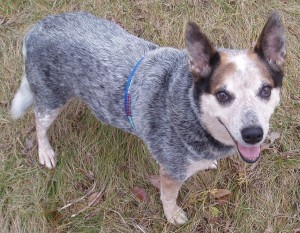8 State Hurricane Kate, an old Australian Cattle Dog, was rescued from a rooftop in Louisiana nine days after Hurricane Katrina. I met her in September 2005 in Gonzales, Louisiana, where rescued animals were taken for care and shelter.
With no known address or ID, she was running out of options. When Hurricane Rita forced our evacuation, I drove home to Minnesota, through eight states, with Kate in a kennel in the back seat. While fostering Kate, I listed her on Petfinder and searched for her original family, even posting a “Do You Know This Dog?” video on YouTube.com. Yet five years after Hurricane Katrina, I still don’t know what her life was like before August 29th, 2005.
Kate’s story holds valuable lessons for all animals. My journey with Kate inspired me to write the Not Without My Dog Resource & Record Book, to organize my dogs’ information in one place, for daily use, travel, and emergencies. This book includes important information from Noah’s Wish, a group dedicated to caring for animals in disasters. The following tips will help keep you and your pets safer and happier.
8 Things I Learned from 8 State Kate
1. Microchip your pet. Katrina showed us how easily pets can lose their collars and IDs. A microchip implanted under the pet’s skin is the best permanent identification. I recommend a microchip even if your pet never leaves the house. A flood, tornado, hurricane, or even a surprise bolt out the door can separate you. A microchip is a small electronic chip with a unique ID number, in a capsule the size of a grain of rice. When a pet is found, the ID number is read by a hand-held scanner and the microchip company is notified. The company looks up the ID number in their database to find the owner. A microchip will only reunite you with your pet if you’ve registered your current contact information.
2. Keep good pet records, including a current photo of you with your pet (to verify ownership) and photos of your pet’s unique identifying characteristics. Store your pet’s vet, food and medication records in one place (like the Not Without My Dog book). Include information on the pet’s daily routine, words the pet knows, and other useful tips for anyone taking care of your pet in an emergency situation. Make sure a designated person knows where your pet’s information is stored, in case something happens to you.
3. Make a disaster plan for your family and pets. Know the most likely natural disasters in your area. If you must stay home, be prepared to survive without assistance. Assemble a kit to meet your family’s basic needs for at least three days. Store it in easily accessible waterproof containers. If you must evacuate, do not leave your pets behind. Have carriers, leashes, and harnesses for your pets. Know the local evacuation routes, how you’ll transport your pets, and where you’ll take them. Plan alternate destinations because emergency shelters for people often don’t allow pets, and pet-friendly hotels fill quickly.
4. Make a family communication plan in case a disaster occurs while you’re separated. Know where your family will meet if you can’t reach each other by phone. Identify a neighbor or petsitter who will get to your pets quickly when they need help and your family is away from home.
5. Make sure your pets are properly vaccinated, treated for fleas and ticks, on heartworm preventative, and spayed or neutered. Healthy pets are better prepared to survive anything, including displacement and housing with other animals. Accepted vaccination protocols are changing, and some flea and tick treatments are not approved by veterinarians. Do your research and decide what’s best for your pet.
6. Socialize and train your pets. Socialize pets to be confident in different situations. Positively trained pets are less likely to get lost. Make sure they know how to walk on a leash/harness and are comfortable riding in their carriers in the car. Teach them to wait before exiting the car by pausing, then giving them a reward.
7. Tune in to your pets. They’re tuned in to you. Give them opportunities to do what they were bred to do. Help them relax and be confident. Appreciate them for who they are. The more connected you are to your pets, the better you will weather anything together.
8. Be resilient. An old girl who has lost everything can recover with dignity and grace, and be happy. Kate taught me this too.
Posted on August 18th, 2010 Filed under: General


Leave a Reply
You must be logged in to post a comment.